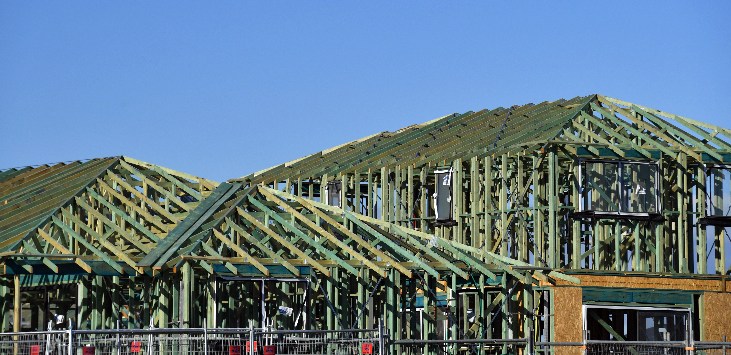
Source: AAP Image/ Mick Tsikas
Australia’s construction sector will have the capacity to build one million new homes over five years, Housing Minister Julie Collins says, as builders question whether the industry has enough workers to carry out the ambitious plan.
Industry groups also say the construction sector could reach that million home goal at a stretch, but fear red tape and tweaked industrial relations laws could hamper those efforts.
Labor’s Housing Australia Future Fund (HAFF) plan is all but certain to pass into law after the federal government reached a deal with the Greens committing a total of $3 billion to the construction of new social and affordable housing.
That funding is set to kickstart construction before the $10 billion HAFF investment vehicle provides funding to 30,000 new social and affordable homes in its first five years.
Separately, state and territory governments have committed to building one million private sector homes between 2024 and 2029 as part of the new Housing Accord.
To drive even more housing developments, the federal government in August confirmed it will provide $3 billion in financial incentives to jurisdictions that push above and beyond the 1 million home target, in the hopes of building 1.2 million new homes.
Those lofty goals arrive after a trying year for the construction sector, in which small builders and contractors struggled to keep up with rising material costs, labour shortages, and a rippling wave of insolvencies.
Fronting the media on Tuesday, Minister for Housing, Minister for Homelessness Julie Collins said the goals are achievable despite persistent challenges facing builders on the ground.
“We know that detached residential dwellings are coming off,” Collins said on Today, appearing to refer to new dwelling approvals declining from their COVID-era highs.
“We anticipate that towards the end of this year, early next year, that the sector will have capacity.
“We’re aiming to fill that with more social and affordable homes to make sure that we can keep the construction sector employed.”
The Housing Accord goal of one million homes is “achievable but ambitious,” Collins added, “and we’re absolutely determined to be ambitious for the Australian people”.
Builders raise questions over construction workforce capacity
Some builders have questioned the plan, voicing concerns over the size of Australia’s construction workforce and its ability to complete a tidal wave of new developments.
Tim Walker, director of Melbourne homebuilder TCON, said the COVID-era building rush, coupled with supply chain inflation, pushed the sector to its limits.
“Everyone is absolutely under the pump at all times, there’s not a single person in the building industry that is sitting on their hands,” Walker told SmartCompany.
The government has flagged the potential labour crunch, with Collins on Tuesday pointing to the government’s fee-free TAFE policy and its potential benefit to the construction sector workforce.
“I guess we’ve got to open the immigration floodgates, and we need to get more apprentices in the door, but that’s not going to be the answer to fulfilling 1.2 million contracts,” Walker said.
Encouraging states and territories to gear their planning and zoning policies towards new home construction is only half of the challenge, he added.
“It’s really easy to sell land to developers and start getting them to subdivide, but who, unless it’s robots, is going to build this?”
Red tape, industrial relations reforms must not get in the way: Master Builders
The base million-home target is possible at a stretch, but the 1.2 million target will require massive effort to achieve, according to Master Builders Association CEO Denita Wawn.
Master Builders Australia estimates construction begun on 173,755 new homes during 2022-23, far short of the 240,000 needed each year to meet the Housing Accord’s stretch goal of 1.2 million homes.
“2023-24 will see home starts decline by another 2.1% to around 170,100, well below the 200,000 needed per year to meet population growth,” Wawn said.
“However, this will likely be a bottoming out point as supply bottlenecks loosen and we return to a more desirable investment market on the demand side.”
Housing supply is forecast to peak at 241,000 in 2026-27.
“In good news, the projected volume of new starts over the five-year period up to 2027-28 exceeds the one million home target under the Housing Accord but only just,” Wawn said.
“There is still a lot of work that needs to be done to achieve the revised target of 1.2 million homes as announced by National Cabinet last month.”
Efforts to radically increase the housing supply must not be unintentionally hampered by incoming industrial relations reforms, she continued.
Master Builders Australia has criticised draft legislation put forward by Minister for Employment and Workplace Relations Tony Burke which could establish new minimum standards for independent contractors engaging in ’employee-like’ forms of work.
While Burke has reiterated those reforms are targeted at the gig economy, MBA is concerned about spillover to self-employed tradespeople.
Those reforms, combined with the Albanese government’s housing push, are “like watching a lone dancer perform a different routine amidst a synchronised troupe – counterproductive and out of place,” Wawn said.
“The productive capacity of the industry is critical to ensuring we can sustain high output levels.
“We need to be attracting more people to the industry and making it easier to do business, not tie a rope around them.”
Handpicked for you

Poolz launches in Australia to make the dream of a backyard pool a reality



COMMENTS
SmartCompany is committed to hosting lively discussions. Help us keep the conversation useful, interesting and welcoming. We aim to publish comments quickly in the interest of promoting robust conversation, but we’re a small team and we deploy filters to protect against legal risk. Occasionally your comment may be held up while it is being reviewed, but we’re working as fast as we can to keep the conversation rolling.
The SmartCompany comment section is members-only content. Please subscribe to leave a comment.
The SmartCompany comment section is members-only content. Please login to leave a comment.